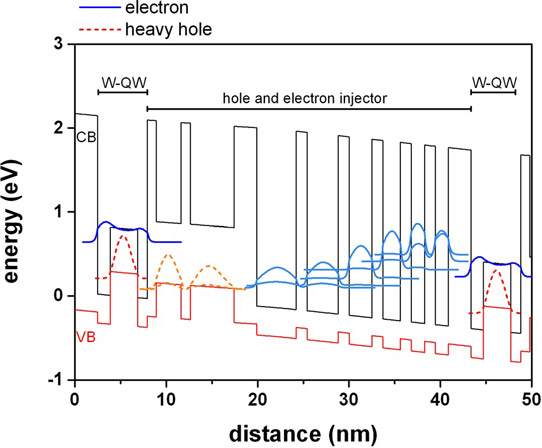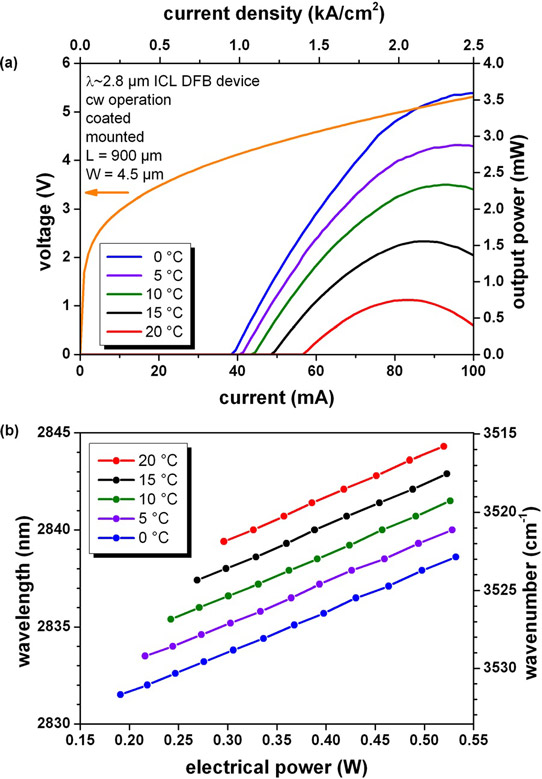- News
8 May 2015
Reducing wavelengths of interband cascade lasers
Researchers based in Germany and UK have claimed record short 2.8μm wavelength performance for interband cascade lasers (ICL) [Julian Scheuermann et al, Appl. Phys. Lett., vol106, p161103, 2015].
The team from nanoplus Nanosystems and Technologies GmbH and Universität Würzburg in Germany and University of St Andrews in the UK are interested in tunable laser absorption spectroscopy (TLAS) or other spectroscopic analysis with a view to a wide variety of chemical and medical applications. Compact and low-power-consuming laser sources would allow such techniques to be more available.
The 3μm region of the mid-infrared spectrum can be used to study stretch vibrations in carbon-hydrogen bonds. Most organic materials have such bonds.
Interband cascade lasers are seen as a sort of hybrid of traditional diode laser and quantum cascade laser (QCL) technology. The 'sweet spot' for emissions is in the range 3.6-3.8μm. Advantages of ICLs over QCLs are lower threshold currents and power consumption. However, ICLs generally have lower output power.
A 5-stage structure was grown on tellurium-doped gallium antimonide (GaSb) using solid-source molecular beam epitaxy. The stages (Figure 1) included a W-type quantum well with 2.5nm AlSb/1.4nm InAs/3.0nm Ga0.65In0.35Sb/1.1nm InAs/1.0nm AlSb. The electron injector region consisted of six InAs/AlSb pairs, with the five nearest to the W-QW highly silicon doped to encourage carrier rebalancing. Although the paper does not report the structure of the hole injector, it seems likely to consist of GaSb/AlSb layers.

Figure 1: Band structure of conduction and valence bands for one and a half stages, containing two W-QWs and respective hole and electron injectors. Dashed (solid) lines depict absolute moduli square of heavy hole (electron) wave functions at W-QW as well as in injector region.
The ICL region was sandwiched in a waveguide with 200nm GaSb confinement on each side and 1.5μm/2.5μm upper/lower cladding with InAs/AlSb superlattice layers. The confinement and cladding were separated by transition layers that smoothed the conduction band discontinuity.
Broad-area, ridge-waveguide (RWG) and distributed feedback (DFB) devices were produced from the epitaxial material. The RWG and DFB laser diodes were passivated with silicon nitride and silicon dioxide.
For the DFB laser diodes, metal gratings on the sides of the ridges were used for longitudinal mode selection. The top contact metals were sputtered. Electrochemical deposition of 10μm of gold provided thermal management. The substrate was thinned to 150μm before deposition of the bottom contact.
The structures were cleaved into bars with 900μm cavities. The devices were further passivated with aluminium oxide on the front facet. The back facet was coated with a highly reflective metal mirror.
The DFB devices were mounted on aluminium nitride heat spreaders and soldered into TO packaging with thermoelectric cooling. The packaging was hermetically sealed. The windows were anti-reflective.
The broad-area LDs had a threshold current density of 383A/cm2 at 20°C under pulsed operation. According to the researchers, the threshold is only slightly higher than for devices with wavelengths longer than 3μm.
Cascaded type-I QW devices have been reported with thresholds as low as 100A/cm2 for quinary diode lasers and around 300 A/cm2 for a superlattice design. QCL thresholds tend to be greater than 2kA/cm2, depending on materials.
The characteristic temperature for the threshold (T0) of the broad-area ICL was 67K, which is claimed by the researchers to be a record for ICL material. The emission wavelength peaked around 2.84μm.
Narrow RWG laser diodes with a 3mm-long, 7.8μm-wide cavity had continuous wave (cw) output power of more than 11mW at 20°C. These diodes emitted laser light up to 50°C. Previous reports of ICLs with emission wavelengths shorter than 3μm have been for broad-area devices in pulsed operation.
The DFB output was up to a few milliwatts (less than 4mW) in cw operation at room temperature. The threshold was at 1.4kA/cm2. The threshold power was 6.2kW/cm2 – much lower than the best indium phosphide QCLs reported so far.

Figure 2: (a) Light output, current and voltage characteristics of ICL DFB device at temperatures ranging from 0°C to 20°C in cw operation. (b) Respective tuning diagram, showing range of single-mode operation. Current tuning range 7nm at 0°C; overall tuning range more than 12nm.
Current-based tuning (Figure 2) gave a 7nm wavelength range (21nm/W, 0.13nm/mA). Combining current and temperature (0.29nm/K) tuning extended this to 12nm. The researchers say that this is more than sufficient for TLAS. By varying the DFB gratings, wavelengths between 2777.5nm and 2928.8nm (a range of more than 150nm) could be produced.
http://dx.doi.org/10.1063/1.4918985
The author Mike Cooke is a freelance technology journalist who has worked in the semiconductor and advanced technology sectors since 1997.


